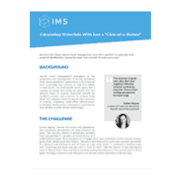5 Ways Commercial Real Estate Investment Firms Can Improve Data Quality and Data Prep
As with most businesses, data is the foundation of effectively running a real estate investment firm. Accurate and current data is critical for every stage in a real estate asset’s life, from acquisition to disposition. Unfortunately, there are very few tools, processes, or safeguards in place at many of these firms. Simple errors, whether it be contact information, account information, or calculations, propagate, wasting time and causing credibility issues. The good news is that implementing the right processes and tools can help to solve these data quality issues.
Based on our experience in working with investor, loan, and property level data, we recommend the following 5 tips to assist with data quality.
1.) Choose scalable systems that will support your business today and in the future.
We see many cases where entire projects are managed in a single spreadsheet. After acquiring a new asset, one of the other spreadsheets is copied, renamed, and used. This is prime for data propagation issues. For example, formula errors in a hurdle rate that was never hit would propagate through to other projects. Think about spreadsheets that include contact and bank information and how hard it would be to update if each project is discrete.
2. ) Decide and enforce what is mandatory.
In many instances, firms do not enforce mandatory versus optional data elements. Additionally they do not enforce standardizations like two letter state abbreviations (NC) versus spelled out names (North Carolina, N. Carolina, etc.). This leaves contact data with holes that, when stored in systems, end up as invalid information. How many 555-555-1212 phone numbers or 123 First Streets are in your customer data? Minimizing data quality issues starts with both the discipline and accuracy of data acquisition and maintenance.
3.) View data as perishable.
Data is perishable. People and businesses move, change phone numbers, get new email addresses, and change bank accounts. Use a CRM To ensure you are regularly reaching out to your investors or other stakeholders to keep data up-to-date. Something as simple as an email to all of your your contacts to ask them to update any information can significantly reduce the amount of invalid data. A side benefit is keeping your firm top-of-mind.
4.) Move your data carefully.
Any time you are moving data from one source to another, whether it be in software or even on paper, it introduces opportunities for data issues. With the risk of data issues at stake, it is critical to audit your data prior to moving it, prepare your data for the actual transition, and have a robust scheme for an “Extract-Transform-Load” (ETL). This will reduce the chances of data issues during the migration process.
5.) Check your work.
Although technology is extremely reliable, a quick human double-check of the data is still relevant and valuable. A quick skim can identify both acute and systemic issues in your data. Don’t be afraid to spend a few minutes checking the data for consistency and accuracy, especially if it is the first time you are moving data or using a new system.
What can you do next?
Data audits, preparation, and quality are critical for your firm’s credibility and profitability. Following the five tips above will ensure a lack of data quality is not derailing your business. Additionally, centralizing your data in a single platform will enable you to better manage your business as it scales. Learn more about how your can fuel your firm’s growth with IMS.











